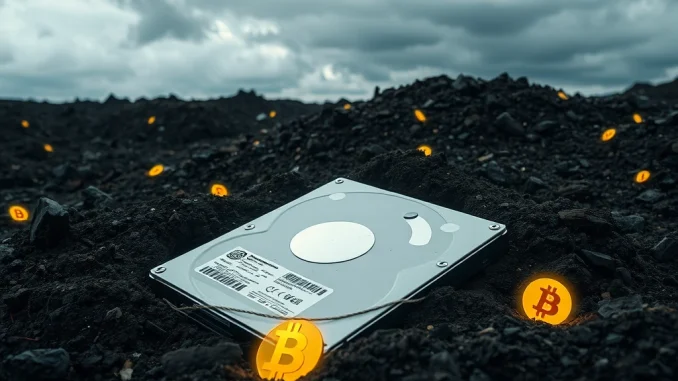
Imagine misplacing a small piece of plastic that holds the key to hundreds of millions of dollars. For James Howells, that nightmare became reality over a decade ago when he accidentally threw away a hard drive containing 8000 Bitcoin. This isn’t just a story about losing a fortune; it’s a captivating tale of perseverance, technology, environmental challenges, and the ultimate digital treasure hunt. Now, this incredible Lost Bitcoin saga is set to reach a wider audience thanks to a new media deal.
The $800 Million Question: What Happened to the Lost Bitcoin?
At the heart of this extraordinary narrative is the disappearance of a digital fortune. Back in 2013, James Howells, an IT professional from Newport, Wales, disposed of an old hard drive. Unbeknownst to him at the time, that drive held the private keys to a wallet containing 8000 Bitcoin. While the value was relatively small back then, the exponential rise of Bitcoin’s price has transformed that discarded drive into a potential jackpot worth over $800 million at its peak.
The sheer scale of the potential loss is what makes this story so compelling. It highlights:
- The incredible volatility and growth of cryptocurrency values.
- The critical importance of secure key management in the digital asset space.
- How a simple mistake can have monumental financial consequences in the crypto world.
Finding this particular piece of hardware within a vast municipal waste site is the central challenge.
Who is James Howells and What Has He Done?
For over ten years, James Howells has been on a relentless mission to recover his lost fortune. He hasn’t just accepted the loss; he has become synonymous with the high-stakes quest to retrieve the hard drive from the depths of the Newport landfill.
His efforts haven’t been low-key. Howells has:
- Made numerous public appeals to the Newport City Council for permission to excavate the landfill site.
- Developed detailed, multi-million dollar plans involving sophisticated scanning equipment, robotic arms, and even AI technology to sort through the waste.
- Assembled a team of experts in areas ranging from data recovery to environmental waste management.
- Pledged a significant portion of the recovered Bitcoin’s value to the local community and environmental projects, attempting to address concerns about the landfill excavation.
Despite these elaborate plans and promises, the council has consistently denied his requests, citing environmental risks, disruption to the local area, and the sheer cost and complexity of the operation.
The Decade-Long Bitcoin Recovery Story: Plans and Setbacks
The narrative of Howells’ quest is a true Bitcoin Recovery Story unlike any other. It involves not just the hope of finding a lost item, but the logistical nightmare of searching a sprawling landfill site that has accumulated years of waste on top of where the drive is believed to be buried.
Howells’ proposed recovery operation is ambitious, outlining a multi-stage process:
- Initial Excavation: Carefully digging up specific sections of the landfill identified as potential locations for the hard drive.
- Material Sorting: Transporting the excavated waste to a temporary facility where it would be mechanically and manually sorted.
- Item Identification: Using scanning technology and human inspection to look for the specific hard drive, estimated to be buried under tons of rubbish.
- Data Recovery: If the drive is found, employing data recovery specialists to attempt to extract the Bitcoin wallet keys, assuming the drive is still intact enough after years underground.
The setbacks have been primarily regulatory and environmental. The council’s refusal centers on the potential for ecological damage, methane release, and the sheer scale of disturbing a regulated waste disposal site. This ongoing battle between individual wealth recovery and public environmental concerns adds another layer to the story.
Navigating the Challenges of the Welsh Landfill
The Welsh Landfill in Newport presents unique and significant obstacles to any recovery attempt. It’s not simply a matter of digging a hole; it’s a complex engineering and environmental challenge.
Key difficulties include:
- Location Uncertainty: Pinpointing the exact location of a small hard drive within a massive, ever-growing waste site is incredibly difficult. The landfill covers a large area, and waste disposal methods mean items can shift over time.
- Depth and Volume: The drive is likely buried deep under many layers of compressed waste, requiring extensive and costly excavation.
- Environmental Risks: Digging a landfill can release harmful gases like methane, disturb hazardous materials, and potentially contaminate soil and groundwater. Environmental regulations are strict for good reason.
- Physical Condition: A hard drive exposed to the elements, pressure, and decomposition processes within a landfill for a decade may be severely damaged, making data recovery improbable even if found.
These challenges underscore why the local authorities have been hesitant to grant permission, despite the astronomical value at stake.
What Does 8000 Bitcoin Represent Today?
While the exact value fluctuates with the market, holding 8000 Bitcoin represents a substantial fortune in the cryptocurrency world. At Bitcoin’s peak, this amount was worth over $800 million, a figure that captures the imagination and highlights the life-changing potential (and risk) associated with early crypto adoption.
This figure isn’t just a number; it represents:
- The dream of financial freedom for James Howells.
- The potential for significant investment into technology and community projects, as Howells has proposed.
- A stark reminder of the volatility and high stakes inherent in the crypto market.
The fluctuating value of the 8000 Bitcoin adds a dynamic element to the story, as the prize changes over time, keeping the public’s interest piqued.
Lebul Steps In: Bringing the Story to the Screen
Recognizing the compelling nature of this tale, entertainment startup Lebul has acquired the rights to develop content around James Howells’ quest. This is a significant step in bringing the Bitcoin Recovery Story to a mainstream audience beyond crypto enthusiasts.
Lebul plans to produce a range of content, including:
- A docuseries: Offering an in-depth look at Howells, his plans, the challenges, and the people involved.
- A podcast: Providing an audio format for interviews, updates, and background on the story.
- Social-first content: Engaging audiences on platforms like TikTok, Instagram, and YouTube with short-form videos and updates.
This multi-platform approach aims to capture different audiences and provide various entry points into the complex story, blending the personal drama with the technical and environmental aspects.
Beyond the Search: Blockchain, Environment, and Hope
The Lost Bitcoin story is more than just a treasure hunt; it touches upon broader themes relevant today. It naturally explores aspects of blockchain technology and cryptocurrency, explaining how such a vast sum can be tied to a small physical object (the hard drive holding the keys).
Furthermore, the story brings environmental issues to the forefront, specifically the challenges and impacts of landfill waste. The debate over excavating the site highlights the tension between resource recovery (digital assets) and environmental protection.
Ultimately, it’s a story fueled by hope – the hope of recovery against seemingly impossible odds. It resonates with anyone who has ever lost something valuable, amplified by the extraordinary value involved.
Summary: The Hunt Continues, Now With Cameras Rolling
James Howells’ quest to recover his 8000 Bitcoin from a Welsh Landfill is one of the most fascinating tales in the cryptocurrency world. It’s a dramatic Bitcoin Recovery Story involving immense wealth, a decade of effort, complex technical plans, and significant environmental hurdles. With Lebul now securing the rights, the world will get a closer look at the determined efforts of James Howells and the incredible stakes involved in the search for the Lost Bitcoin. While the hard drive remains buried, the story is just beginning to surface for a global audience, proving that sometimes, the most captivating treasures are the ones we’ve lost.



